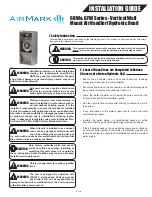
257
Steam Failure Modes
The following failure modes could take as little as a weekend to
damage a coil, or much longer.
Problems occur quickly in coils using low pressure steam
(< 3 psig). Water hammer can develop inside the coil at the header
end because the steam has already condensed and the low steam
pressure does not adequately clear it from the coil. This conden
-
sate re-boils and starts up water hammer inside the tubes. The ac
-
tion of this type of water hammer, which sounds like crackling in
-
side the coil, is many tiny bubbles impinging on the inner and out
-
er tubes. One result is the inner tube gets work hardened and
eventually shatters. Another result is the eventual erosion of the
outer tube causing pinhole leaks.
Coils which are not properly vented will eventually load up with
noncondensable gases. Coil performance (temperature rise) drops
off as the noncondensables act as insulation inside the tubes.
The coils may also fill with condensate. The collapsing steam
causes a vacuum inside the coil when the supply valve closes. The
trapped condensate will then freeze causing the tubes to rupture
after it melts. The use of a vacuum breaker at the condensate dis
-
charge will aid in relieving the vacuum in the coil and promote
condensate drainage.
Refer to Tables 50 and 51 for 39M troubleshooting information.
Water coil performance (when piped in parallel flow) will be re
-
duced by approximately 5% for each coil row on coils 2 rows
deep and deeper. Coils should always be piped with the water inlet
on the leaving air side of the coil, regardless of water connection
vertical position.
VFD Diagnostics
The drive detects error situations and reports them using:
• the green and red LEDs on the body of the drive (located
under the keypad)
• the status LED on the control panel
• the control panel display
• the Fault Word and Alarm Word parameters bits
(parameters 0305 to 0309)
The form of the display depends on the severity of the error. The
user can specify the severity for many errors by directing the drive
to ignore the error situation, report the situation as an alarm, or re
-
port the situation as a fault.
FAULTS (RED LED LIT)
The VFD signals that it has detected a severe error, or fault, by:
• enabling the red LED on the drive (LED is either steady or
flashing)
• setting an appropriate bit in a Fault Word parameter (0305
to 0307)
• overriding the control panel display with the display of a
fault code
• stopping the motor (if it was on)
The fault code on the control panel display is temporary. Pressing
the MENU, ENTER, UP button or DOWN buttons removes the
fault message. The message reappears after a few seconds if the
control panel is not touched and the fault is still active.
ALARMS (GREEN LED FLASHING)
For less severe errors, called alarms, the diagnostic display is advi
-
sory. For these situations, the drive is simply reporting that it had
detected something unusual. In these situations, the drive:
• flashes the green LED on the drive (does not apply to
alarms that arise from control panel operation errors)
• sets an appropriate bit in an Alarm Word parameters (0308
or 0309)
• overrides the control panel display with the display of an
alarm code and/or name
Alarm messages disappear from the control panel display after a
few seconds. The message returns periodically as long as the
alarm condition exists.
CORRECTING FAULTS
The recommended corrective action for faults is shown in the fault
codes listing in Table 52. The VFD can also be reset to remove the
fault. If an external source for a start command is selected and is
active, the VFD may start immediately after fault reset.
To reset a fault indicated by a flashing red LED, turn off the power
for 5 minutes. To reset a fault indicated by a red LED (not flash
-
ing), press RESET from the control panel or turn off the power for
5 minutes. Depending on the value of parameter 1604 (FAULT
RESET SELECT), digital input or serial communication could
also be used to reset the drive. When the fault has been corrected,
the motor can be started.
HISTORY
For reference, the last three fault codes are stored into parameters
0401, 0412, 0413. For the most recent fault (identified by parame
-
ter 0401), the drive stores additional data (in parameters 0402
through 0411) to aid in troubleshooting a problem. For example, a
parameter 0404 stores the motor speed at the time of the fault. To
clear the fault history (all of Group 04, Fault History parameters),
follow these steps:
1. In the control panel, Parameters mode, select parameter
0401.
2. Press EDIT.
3. Press the UP and DOWN button simultaneously.
4. Press SAVE.
CORRECTING ALARMS
To correct alarms, first determine if the Alarm requires any correc
-
tive action. Action is not always required. Use Table 53 to find and
address the root cause of the problem.
WARNING
Disconnect power and allow all rotating equipment to stop
before servicing unit. Physically secure all fans before per
-
forming unit service. Failure to do so may result in serious per
-
sonal injury or death.







































